Seven thousand years of history has endowed Egypt with a treasure trove of the most spectacular landmarks on earth. Egypt’s landmarks are impressive to see as a testament to the advanced culture and technology that existed thousands of years ago. From engineering wonders, such as the Great Pyramids, to underground systems and mysterious temples, exploring these mind-boggling landmarks in Egypt should be on your bucket list.
According to a famous travel quote by Agatha Christie: “All Egypt is obsessed with death! And do you know why, Renisenb? Because we have eyes in our bodies, but none in our minds.” This list of famous Egyptian landmarks through the centuries certainly validates her statement.
Contents
- Egypt Landmarks
- Old Kingdom Landmarks in Egypt
- Egyptian Landmarks in the Middle Kingdom
- New Kingdom Landmarks in Egypt
- Egypt Landmarks of the Ptolemaic Period
- Egypt Landmarks from the Roman Period
- Natural Landmarks in Egypt
- Egypt Landmarks from the Arab and Ottoman Period
- Egypt Landmarks built when it was a British Protectorate
- 20th-Century Egyptian Landmarks
Egypt Landmarks
Old Kingdom Landmarks in Egypt
1- Pyramids of Giza
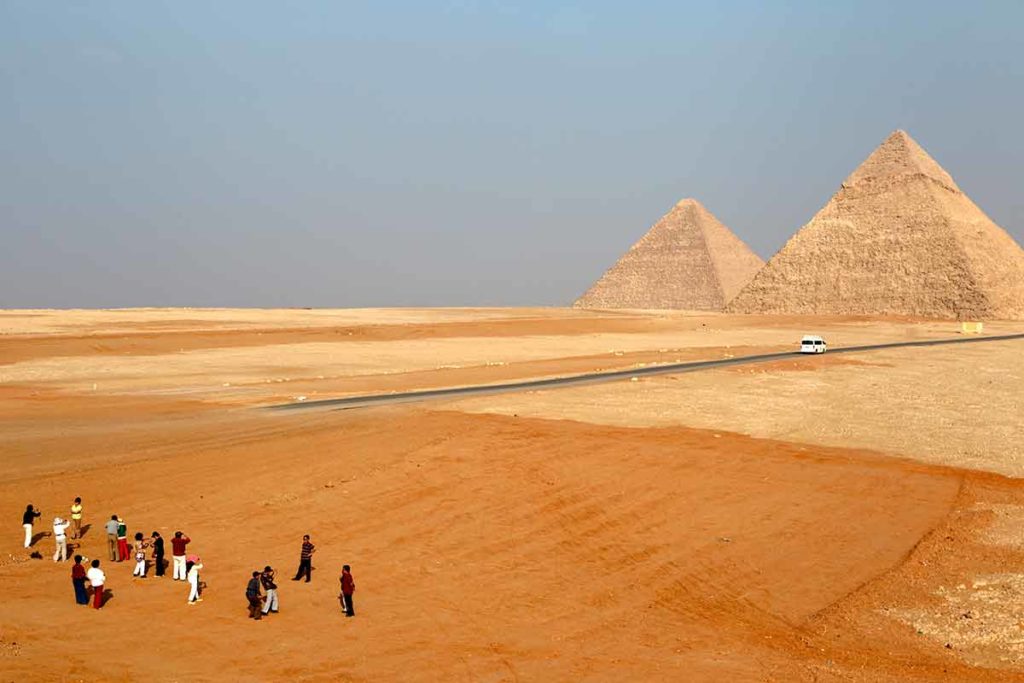
Mention Egypt and what’s most likely to pop to mind are images of the mysterious Egyptian pyramids.
Although there are more than 100 pyramids throughout Egypt, the three pyramids on the outskirts of Cairo are the most visited Egyptian landmarks.
Built 4500 years ago, they were temples for three generations of Pharaohs (Khufu, Khafre and Menkaura) who expected to become gods after death.
The Great Pyramid is the largest pyramid and an engineering marvel constructed with over two million stone blocks.
That’s mind-boggling, considering how long ago the pyramids were built.
Nobody knows how the builders of the great pyramids of Giza managed to move massive limestone and sandstone blocks weighing at least 1.5 tons as well as 30-ton granite blocks.
Entrance fees to the area to see the Pyramids of Giza are 160 EGP (adult) and 80 EGP (student), but if you want to enter the pyramids, it costs extra.
The Great Pyramid costs 360 EGP (adult) and 180 EGP (student), while the other pyramids are 100 EGP (adult) and 50 EGP (student).
The Pyramids of Giza are at Al Haram, Nazlet El-Semman, Al Haram, Giza Governorate, Egypt.
2- The Sphinx
Although the Sphinx and the Pyramids of Giza are in the same complex, making Giza one of the most popular places to visit in Egypt, they are different icons. They deserve to be listed as individual Egyptian landmarks.
Guarding the Pharaoh’s tombs is the Great Sphinx of Giza, a mythical creature from Greek mythology with the head of a man and a body of a lion.
Built during the reign of Pharaoh Kafre, it’s not only one of the world’s oldest statues, it’s one of the largest statues in the world.
Measuring 238 ft (73 m) long and 68 ft (20 m) tall, the Sphinx is an impressive landmark of Egypt.
The Giza pyramids and Sphinx complex can be reached from Cairo by public transport, but the easiest way to explore is by going on a tour.
For more amazing European Landmarks, read:
- 30 Spain Landmarks
- 20 Switzerland Landmarks
- 22 Germany Landmarks
- 35 London Landmarks
- 30 France Landmarks
- 20 Italy Landmarks
- 20 Greece Landmarks
- 20 Russia Landmarks
- 20 Scotland Landmarks
- 20 Ireland Landmarks
- 21 Wales Landmarks
- 20 Turkey Landmarks
- 20 England Landmarks
- 20 Hungary Landmarks
- 21 Romania Landmarks
- 20 Ukraine Landmarks
- 20 Athens Landmarks
- 20 Rome Landmarks
- 20 England Landmarks
- 20 Portugal Landmarks
- 20 Poland Landmarks
- 20 Iceland Landmarks
- 20 Bulgaria Landmarks
- 21 Croatia Landmarks
- 20 Bulgaria Landmarks
- 20 Austria Landmarks
- 21 Finland Landmarks
- 20 Sweden Landmarks
- 20 Denmark Landmarks
- 20 Belgium Landmarks
- 20 Netherlands Landmarks
- 20 Barcelona Landmarks
- 21 Czech Republic Landmarks
- 20 Landmarks in Paris
- 20 Landmarks in Liverpool
- 10 Istanbul Landmarks
Egyptian Landmarks in the Middle Kingdom
3- Karnak Temple
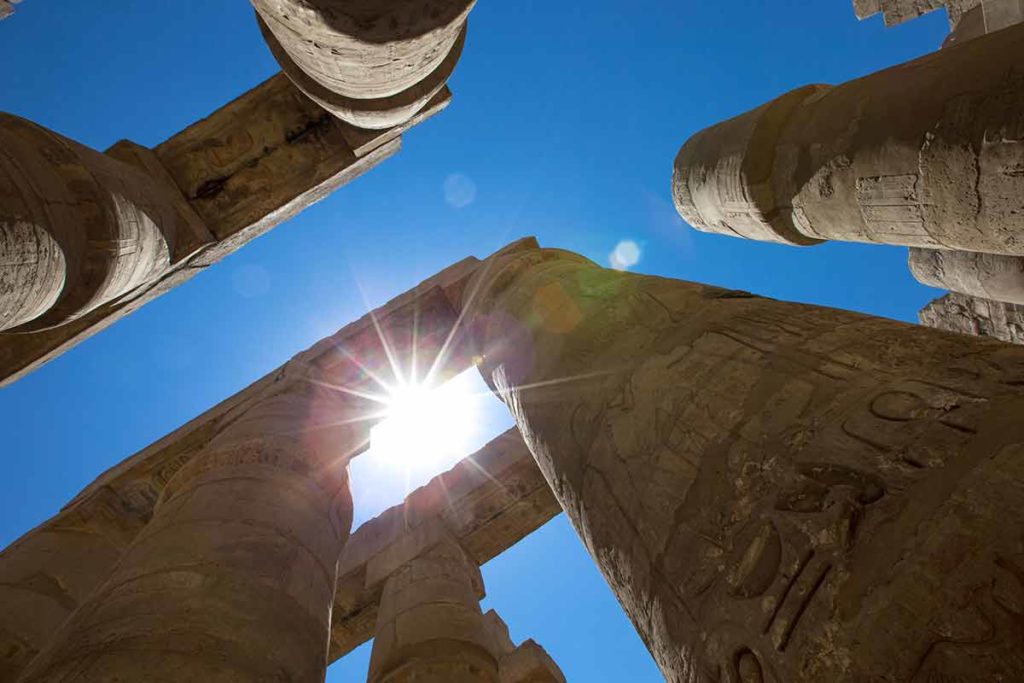
Karnak Temple was built over 2000 years, starting during the Middle Kingdom and continuing through to the New Kingdom and the Ptolemaic Dynasty.
Sprawled over an area of 247 acres (100 ha), It’s one of the largest temples in the world and an Egyptian landmark of mammoth proportions.
You could spend days wandering through Karnak temple exploring its wonders, such as the Hypostyle Hall’s soaring columns and the three km-long avenue of sphinxes.
30 Pharaohs were involved in building Karnak Temple over the centuries., making it one of the main tourist icons in Luxor (ancient Thebes) today. Here are more things to do in Luxor.
The entrance fee to the Karnak Temple costs 150 EGP (adult) and 75 EGP (student).
Karnak Temple is in Al-Karnak village on the East Bank of the Nile near Luxor.
New Kingdom Landmarks in Egypt
4- Colossi of Memnon
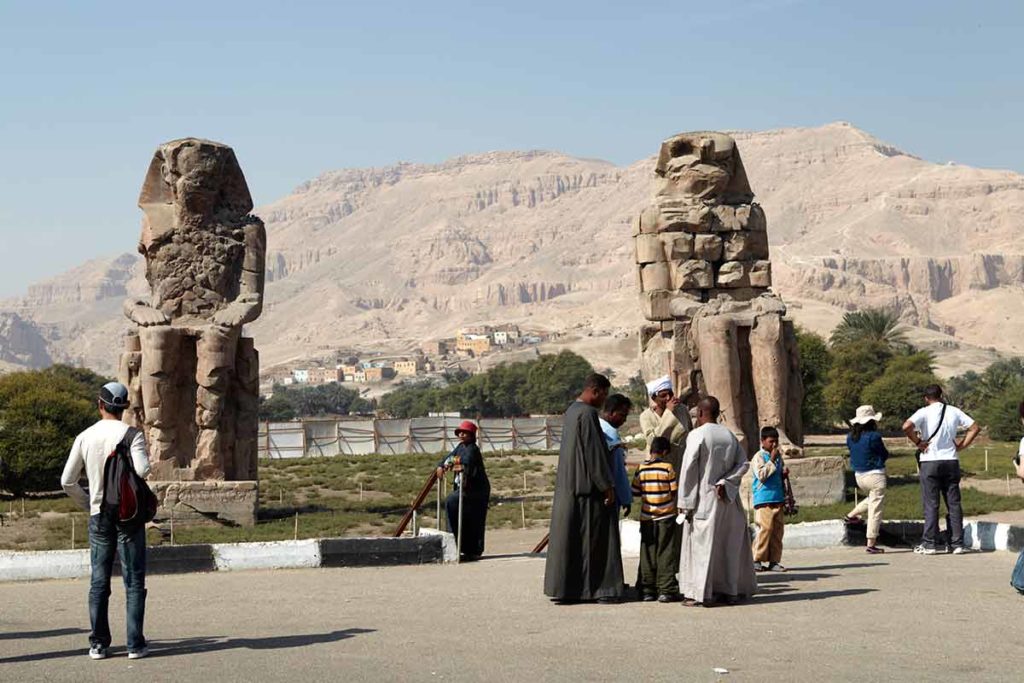
Although the Colossi of Memnon may not look as impressive as some of the other grand-scale Egyptian landmarks, during its heyday, the complex was considered more impressive than Karnak.
Two statues of Pharaoh Amenhotep III were erected to guard his mortuary complex. They face the Nile River and the sun while several other figures surround the main statues.
The statues were built in 3400 BCE, making them one of the oldest landmarks in Egypt.
Each statue is 18m tall and carved from a single sandstone block.
The reason it’s called the Colossi of Memnon is that at some point in history, Egyptologists believe that Memnon (the King of Ethiopia who was killed by Greek champion Achilles) was the same person as Pharaoh Amenhotep.
Entrance to the Colossi of Memnon: free. The Colossi of Memnon is near Luxor on the west bank of the Nile River.
5- Hatshepsut Temple
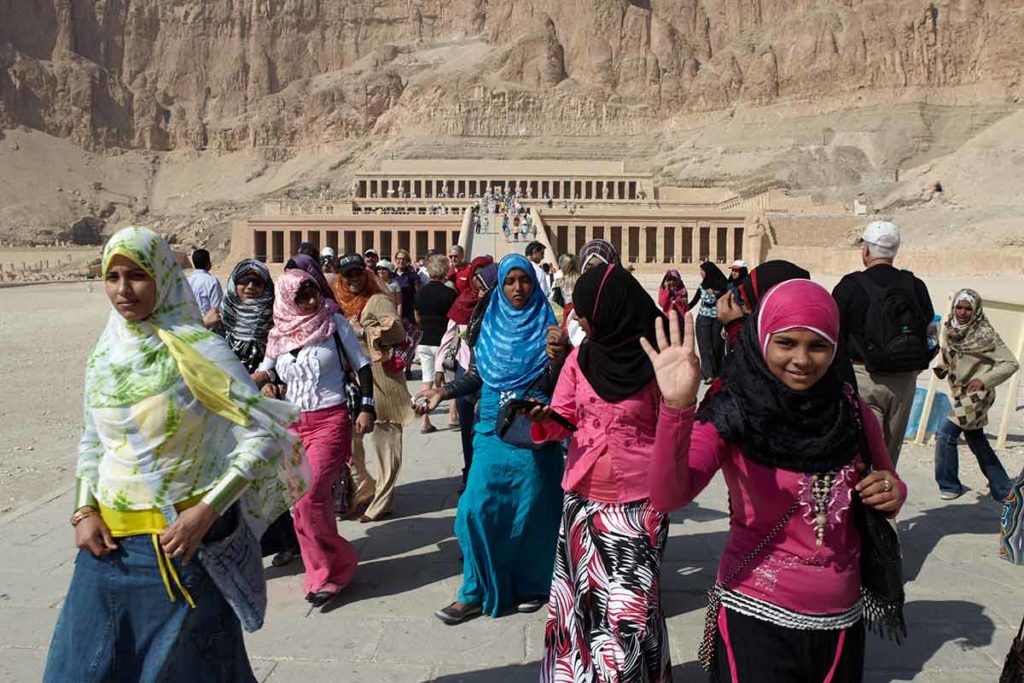
The half-sister of Thutmose II (1492-1479 BCE), Queen Hatshepsut (1479-1458 BCE) was an impressive female Pharaoh and her mortuary temple at Deir el-Bahri is a landmark in Egypt not to be missed.
When Thutmose II died, Hatshepsut ruled as regent in the name of her stepson Thutmose III, who was a child.
During her regency, Hatshepsut was the ruler of Egypt in every way but in name, which encouraged her to call herself “Pharaoh” seven years into her regency.
The Mortuary Temple of Hatshepsut is at Kings Valley Rd, Qesm Al Wahat Al Khargah, New Valley Governorate, Egypt.
6- Valley of the Kings
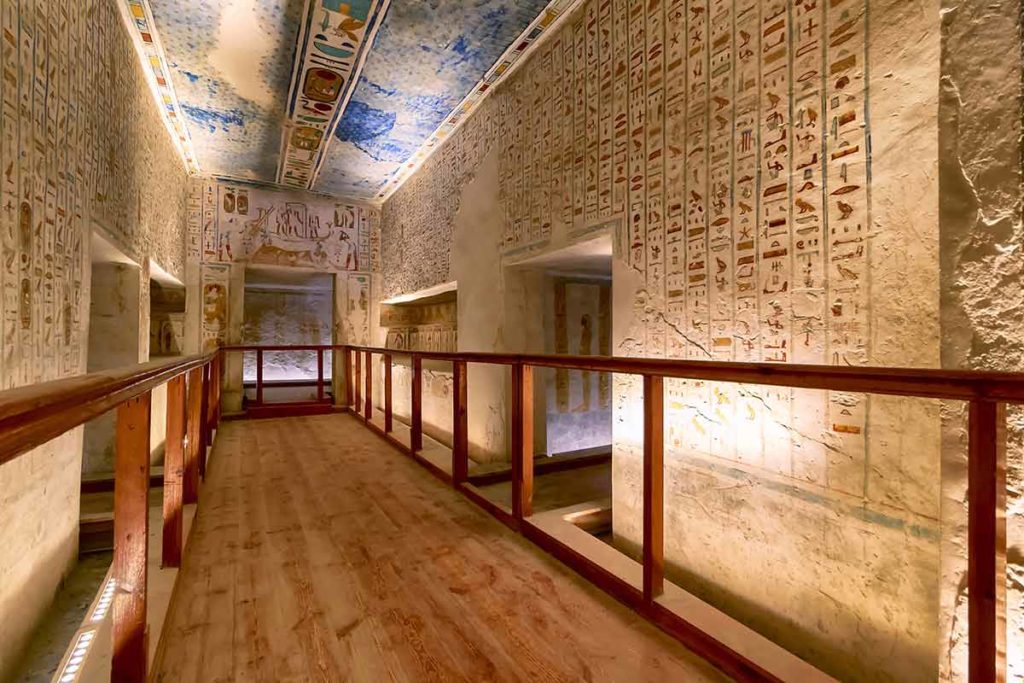
Did the ancient Pharaohs have any inkling that the largest cemetery for Pharaohs in Egypt would one day become an Egyptian landmark that attracts visitors from around the world?
With 62 Pharaoh’s tombs, it’s not surprising the Valley of Kings is often referred to as the “gateway to the afterlife”.
The tombs were built between the 11th and 16th century BC and some of Egypt’s most famous Pharaohs, such as Tutankhamun, Seti I and Ramesses II, were buried here.
Entrance fees to the Valley of the Kings include entry to three tombs and is 200 EGP (adult) and 100 EGP (student).
Valley of the Kings is on the West Bank of the Nile.
7- Abu Simbel
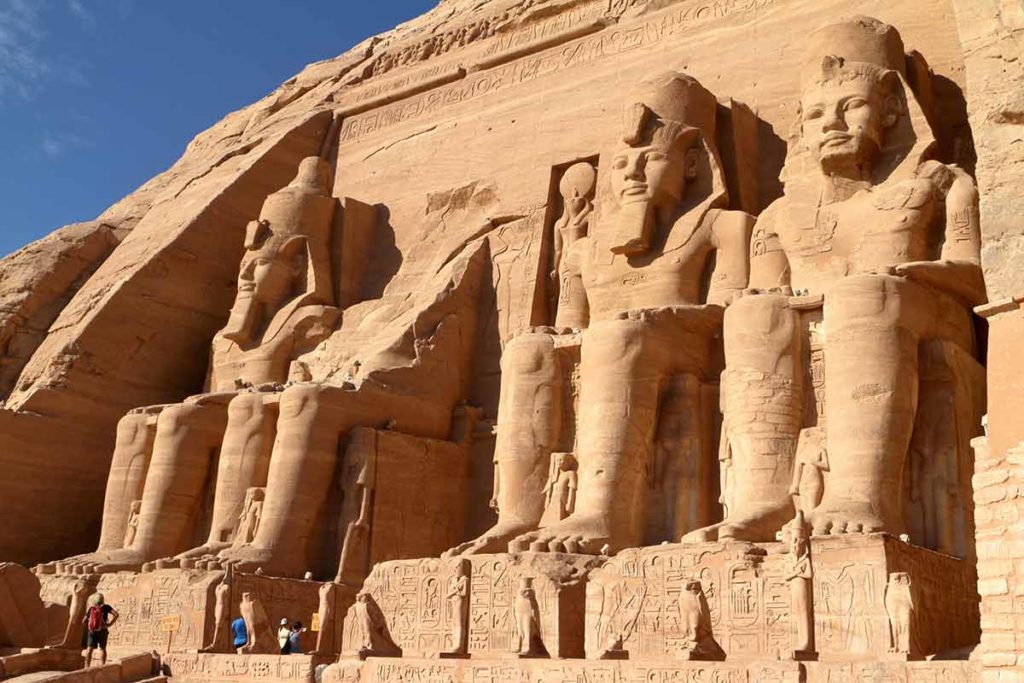
A legacy of Ramses II, Abu Simbel is an icon of ancient Egypt built in 3rd century BC. Abu Simbel is impressive because there are two temples carved into a cliff on the banks of Lake Nasser.
Equally impressive are the four gigantic statues (colossi) of Ramses II at the entrance of the Great Temple carved into the cliff face.
The Small Temple has four statues of the Pharaoh and two of his Queen, demonstrating the enormous respect Nefertari had.
Images of Ramesses and Nefertari making offerings to the gods adorn the temple’s internal walls.
When the Aswan Dam was constructed, the temples faced being submerged by the rising water level of Lake Nasser, so, in 1964, they were moved 60 m above their original site.
Abu Simbel is in the Nubian village on lake Nasser, 230 km southwest of Aswan. The entrance fee is 200 EGP (adult) and 100 EGP (student).
8- Temple of Habu
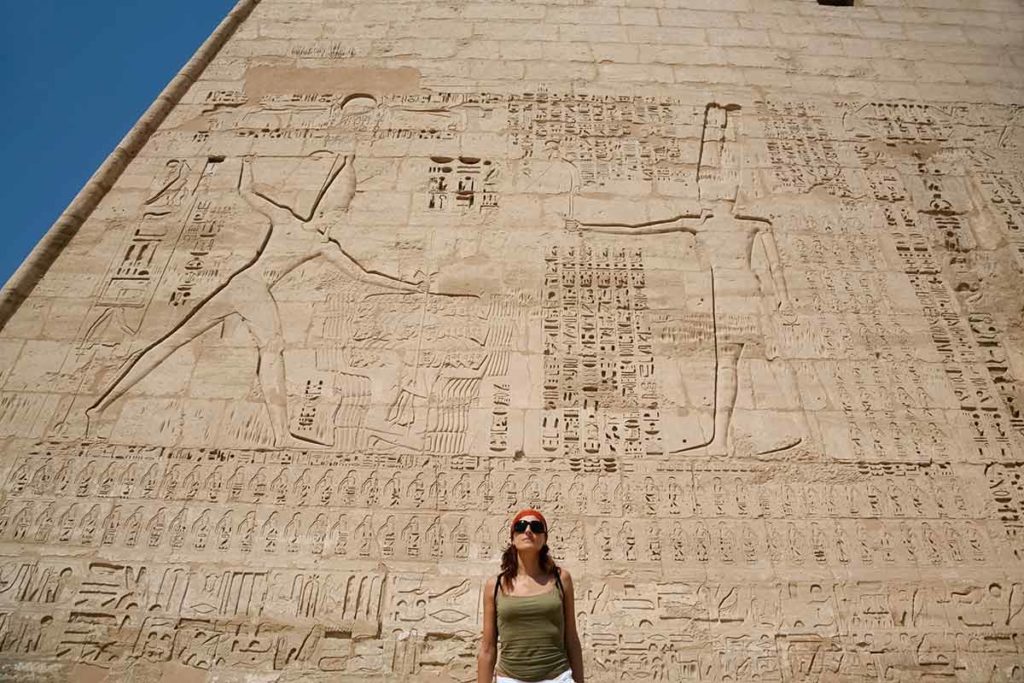
Four miles (6.5 km) from the Valley of the Kings, also n the Nile’s West Bank, is the Mortuary Temple of Ramesses III, the last Pharaoh of the New Kingdom.
Also known as Medinet Habu, it has stunning carvings and well-preserved bas-reliefs that depict rituals and scenes from war.
Although Ramses III had a Mortuary Temple, the Pharaoh’s tomb is in the Valley of the Kings.
The entrance fee to the Habu Temple costs 80 EGP (adult) and 40 EGP (student).
The Temple of Habu is at Al Bairat, Luxor, Luxor Governorate, Egypt.
More Landmarks in Asia:
Egypt Landmarks of the Ptolemaic Period
During the Ptolemaic Period, Alexander the Great conquered Egypt and his general, Ptolemy, founded a dynasty. It’s also the era when Cleopatra died (30 BCE), and Egypt became part of the Roman Empire.
9- Sanctuary of Isis
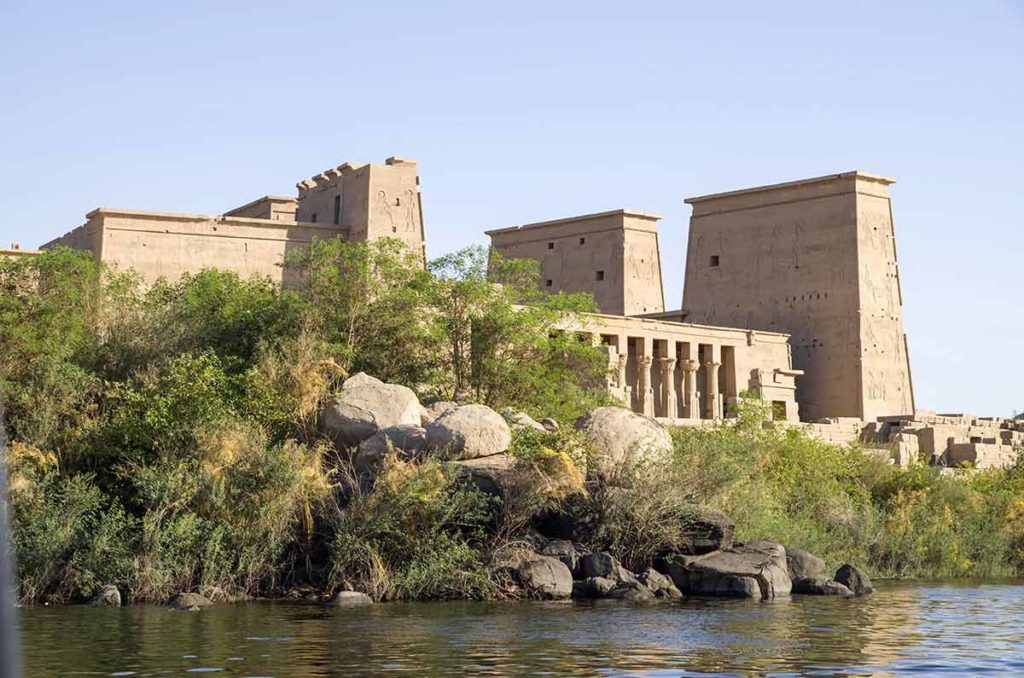
Like Abu Simbel, the Temple of Isis was also relocated due to the rising water level of the Aswan dam.
It was moved from the island of Philae to Agilkia Island as part of a large-scale UNESCO World Heritage project to preserve one of Egypt’s precious landmarks.
These landmarks were dismantled, moved to other sites, and reassembled in locations where they would be safe from the waters of the Aswan dam.
Built during the Greco-Roman era, the Isis Sanctuary was originally a sacred place to worship the Egyptian goddess Isis, but in 540AD, it became a church.
Isis was an Egyptian Queen who married to Pharaoh Osiris.
The Sanctuary of Isis is on Agilkia Island. The entrance fee is 140 EGP (adult) and 70 EGP (student).
10- Temple of Horus in Edfu
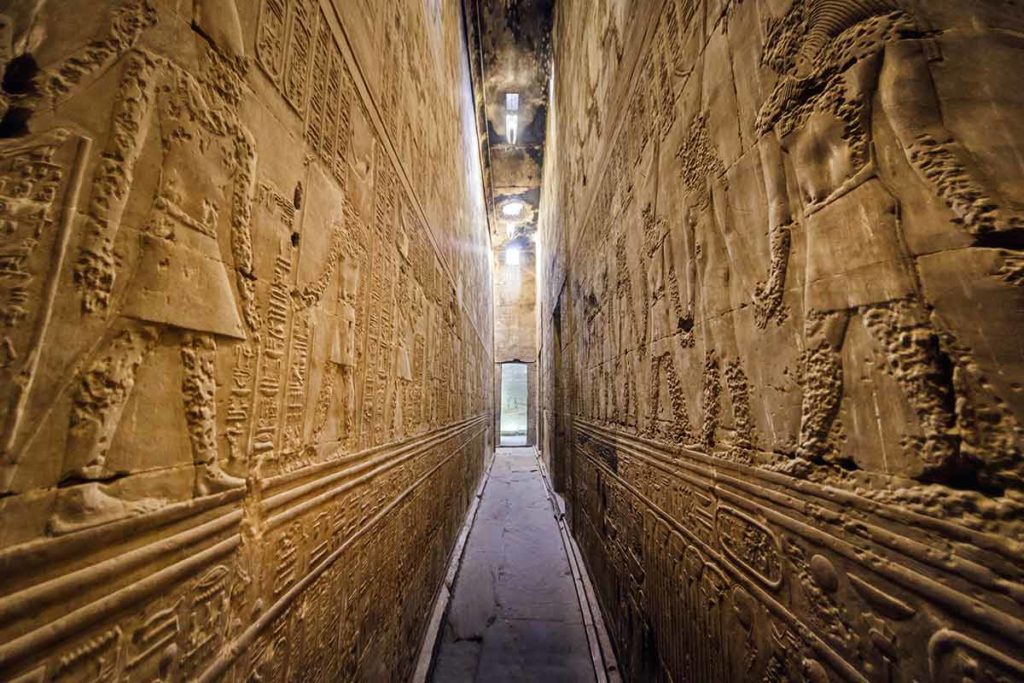
The “Eye of Horus” is a symbol used as a charm to ward off evil (the right eye of Horus represents the sun while the left eye is the moon).
Located at the midpoint between Luxor to the north and Aswan to its south, the Temple of Horus in Edfu is dedicated to the god of the sky.
The son of Osiris and Isis and Osiris, Horus was married to the Egyptian goddess of Love, Music, Beauty, and Happiness – the goddess Hathor.
The Edfu Temple is a Ptolemaic temple built between 237 and 57 BC (the Greco-Egyptian Ptolemies ruled Egypt from 323 to 30 BC).
Two enormous statues of Horus guard the temple’s 36m-high pylon gateway as a falcon.
Inside the temple are courts, columns and walls with reliefs, including the famous ‘Feast of the Beautiful Meeting’ representing the union of Horus of Edfu and Hathor of Dendara.
The entrance fee to the Edfu Temple costs 140 EGP (adult) and 7o EGP (student).
The Temple of Horus in Edfu is in Adfo, Markaz Edfo, Aswan Governorate, Egypt.
11- Temple of Kom Ombo
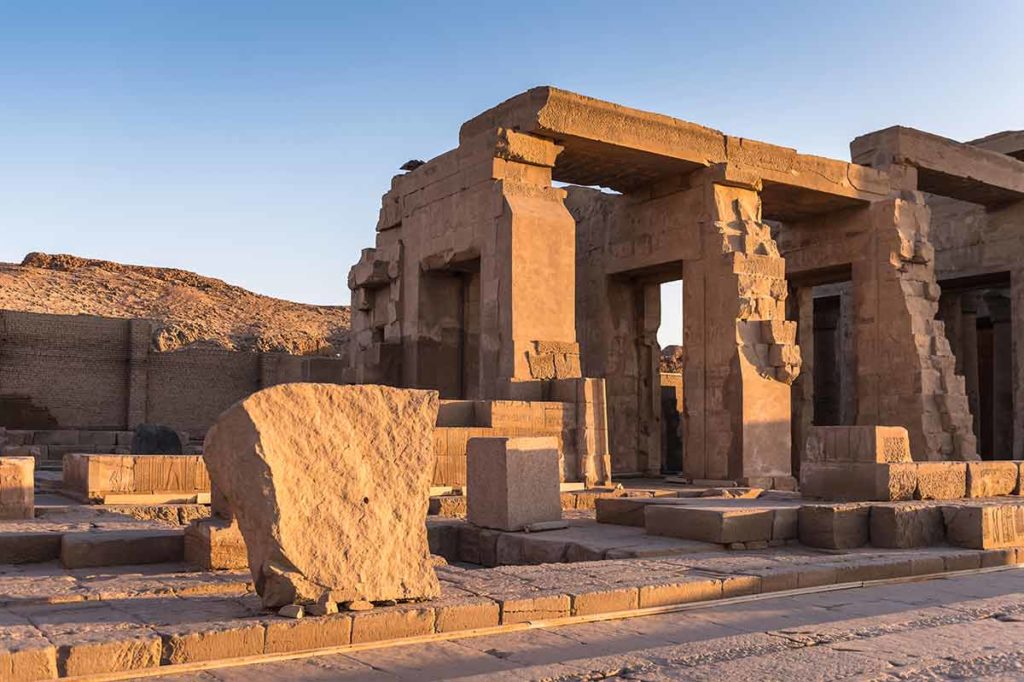
Dedicated to two rival gods, gives the Kom Ombo temple good reason to be on Egypt’s famous landmark list.
The god with the crocodile head, Sobek (god of the Nile, fertility and rebirth), shares the temple with the falcon head god of the sky, Horus.
The temple has two of everything – two entrances, two hypostyle halls, two chambers and twin sanctuaries – one for each god.
The entrance fee to the Kom Ombo Temple and Crocodile Museum is 100 EGP (adult) and 50 EGP (student).
Kom Ombu temple is at Nagoa Ash Shatb, Markaz Deraw, Aswan Governorate, Egypt. It’s 28 miles (45 km) from Aswan, 40 miles (65 km) from Edfu and 105 miles (168 km) from Luxor.
12- Catacombs of Kom El Shoqafa
Built in Alexandria in the 2nd century AD, the Kom al-Shoqafa catacombs are a UNESCO World Heritage site.
The catacomb art is a fusion of Egyptian, Greek and Roman influences, where Anubis (the Egyptian god of embalming and the dead) is dressed as a Roman legionary and has the serpent tail of Agathos (the Greco-Roman god of Fortune).
Entrance fees to Kom al-Shoqafa are 80 EGP (adult) and 40 EGP (student).
Kom El Shoqafa catacombs is in Qesm Karmouz, Alexandria, Egypt.
Egypt Landmarks from the Roman Period
13- Monastery of St Catherine and Mount Sinai
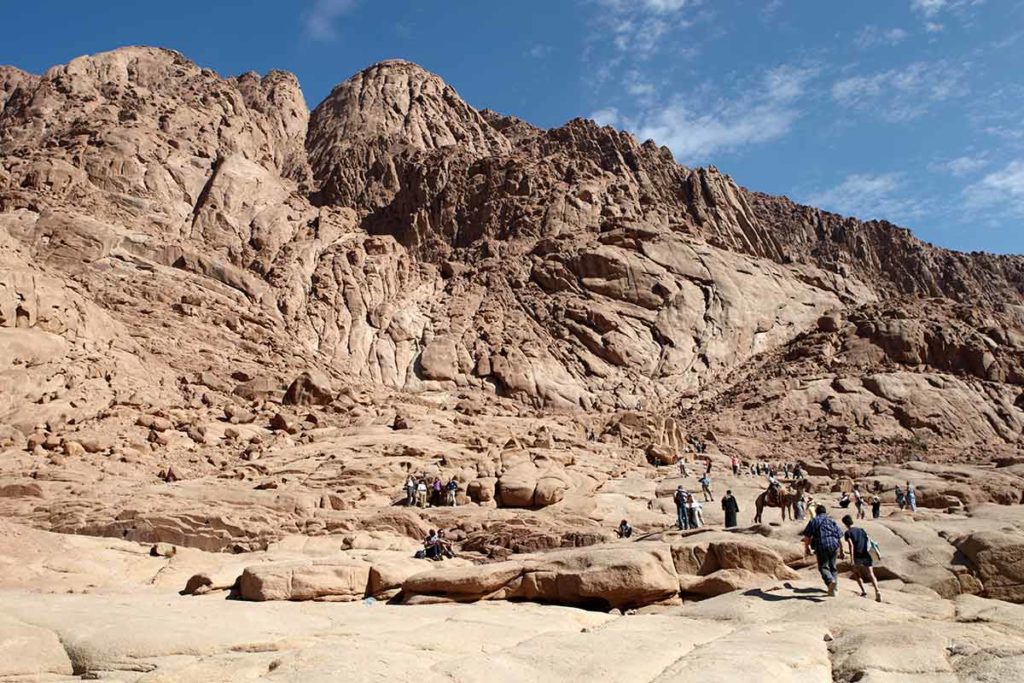
Built on the site beneath Mount Sinai, where God spoke to Moses from a burning bush, St Catherine’s monastery is believed to be one of the oldest monasteries in the world.
Emperor Justinian I (527 to 565) built the monastery beneath the mountain where Moses received the Ten Commandments, making it a sacred place for Christians, Muslims and Jews.
The monastery is home to the Church of the Transfiguration, the oldest library in the world (not open to the public) and the most extensive Christian library outside the Vatican.
It’s famous for the 12th-century painting of the Ladder of Divine Ascent and has parchments from the world’s oldest bible, the Codex Sinaiticus.
St Catherine’s Monastery is at Sharm Ash Sheikh, South Sinai Governorate, Egypt.
Natural Landmarks in Egypt
14- Nile River
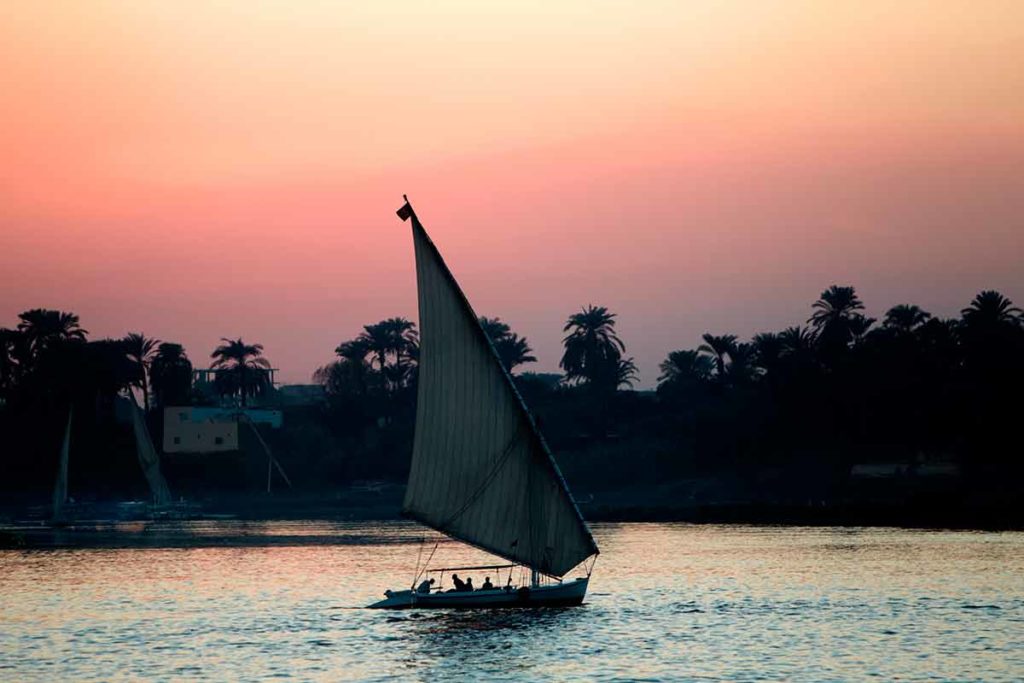
Nile River cruises between Luxor and Aswan are a popular way to see several of Egypt’s famous landmarks.
15- Pharaoh’s Island
Pharaoh’s Island or Coral Island, is a granite atoll surrounded by the coral reef, including Picasso Reef with a mountain in the sea.
The Salah El Din Citadel was built by crusaders and is a UNESCO World Heritage Site.
Pharaoh’s Island is 7 km south of Taba in the Gulf of Aqaba.
Egypt Landmarks from the Arab and Ottoman Period
16- Khan El-Khalili
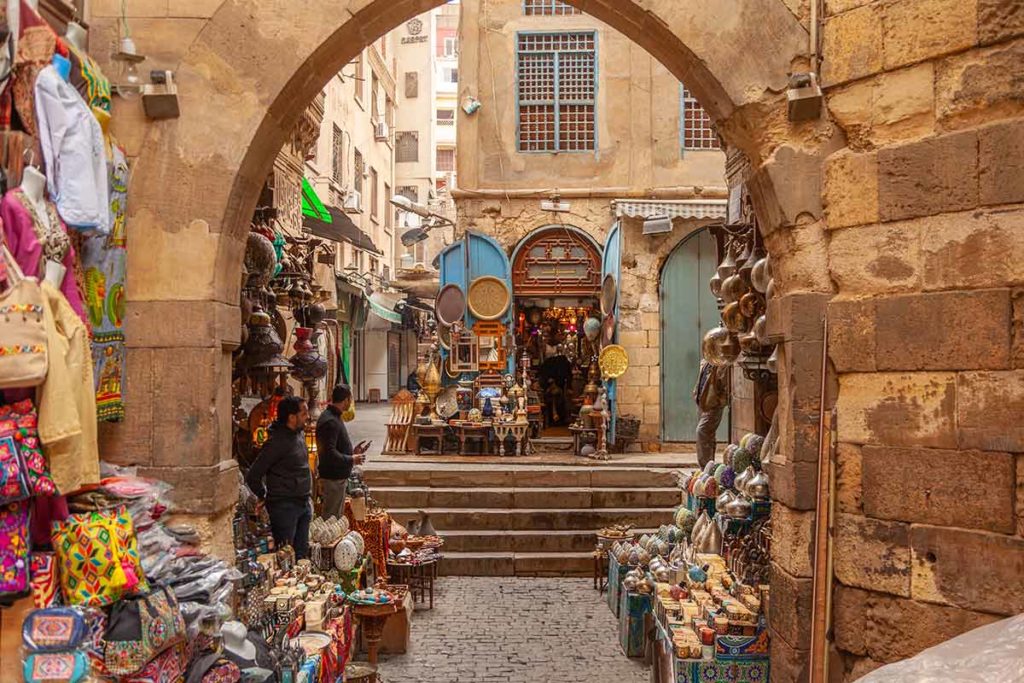
If you love shopping, Khan El-Khalili is a famous Egyptian landmark you will want to visit several times.
Khan El-Khalili bazaar is a step back into the past into an ancient Arabian sou that is now a famous landmark in Egypt.
It’s a chaotic world where shopkeepers haggle and the exotic aromas of perfume and spices waft through the air.
If you love bazaars, you’ll be in heaven at Khan El-Khalili haggling over the price of figurines, jewellery, Aladdin-style lamps and virtually anything you can think of to buy.
If you hate shopping, the bazaar is an architectural landmark of Egypt, with Ottoman empire gates and a warren of alleyways.
Khan El Khalili Bazaar was built when Cairo was founded in 970 AD, originally as burial grounds for the Caliphs and part of the Fatimid Great Eastern Palace.
The Fatimid dynasty ruled an empire that stretched across North Africa and the Middle East from AD 909 to 1171.
Khan El-Khalili is at El-Gamaleya, El Gamaliya, Cairo Governorate, Egypt.
17- Al-Hussein Mosque
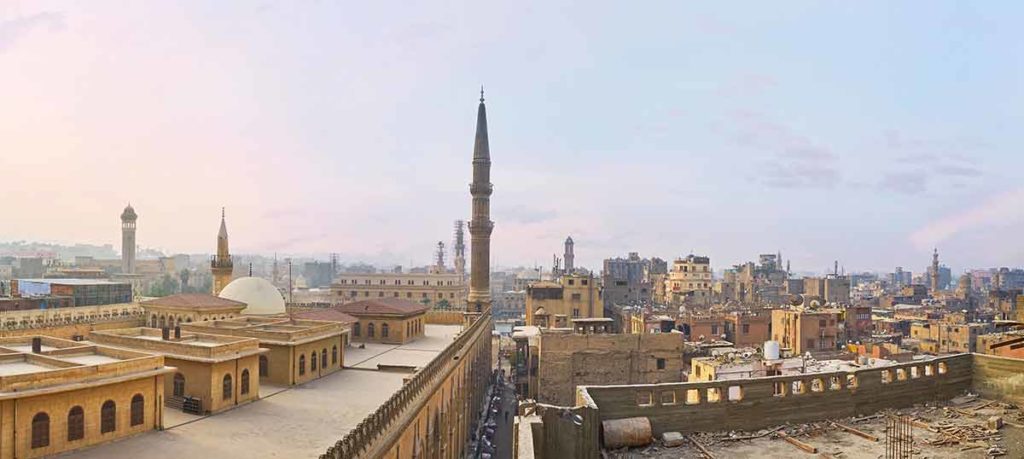
Next to the Khan Khalili Bazaar, the Al Hussein Mosque is another famous landmark in Egypt.
Built in 1154 and rebuilt in the 19th century, the mosque has a recognisable minaret with stucco panels from the 14th century.
It also houses the oldest complete manuscript of the Quran.
Al Hussein Mosque is at 36 Al Mashhad Al Husseini, El-Gamaleya, El Gamaliya, Cairo.
Egypt Landmarks built when it was a British Protectorate
18- Egyptian Museum
Not only is Cairo’s Egyptian Museum a treasure house of some of the world’s most impressive ancient artefacts, but the building itself is also a landmark in Egypt.
Founded in 1858, The Museum of Egyptian Antiquities has 120.000 ancient Egyptian artefacts, including a collection of Egyptian mummies, exquisite jewellery and other ancient treasures.
Its most important items are King Tutankhamun’s sarcophagus and a golden death mask.
A new Grand Egyptian Museum (GEM) is currently under construction near the Pyramids of Giza and is expected to open in 2020.
The museum opens from 9 am to 7 pm, except for Fridays when it closes between 11 am and 130pm.
The Museum of Egyptian Antiquities in Cairo is at Tahrir Square rd Tahrir Square، Egypt. It costs 300 EGP (adult) and 150 EGP (student).
19- Mausoleum of the Aga Khan
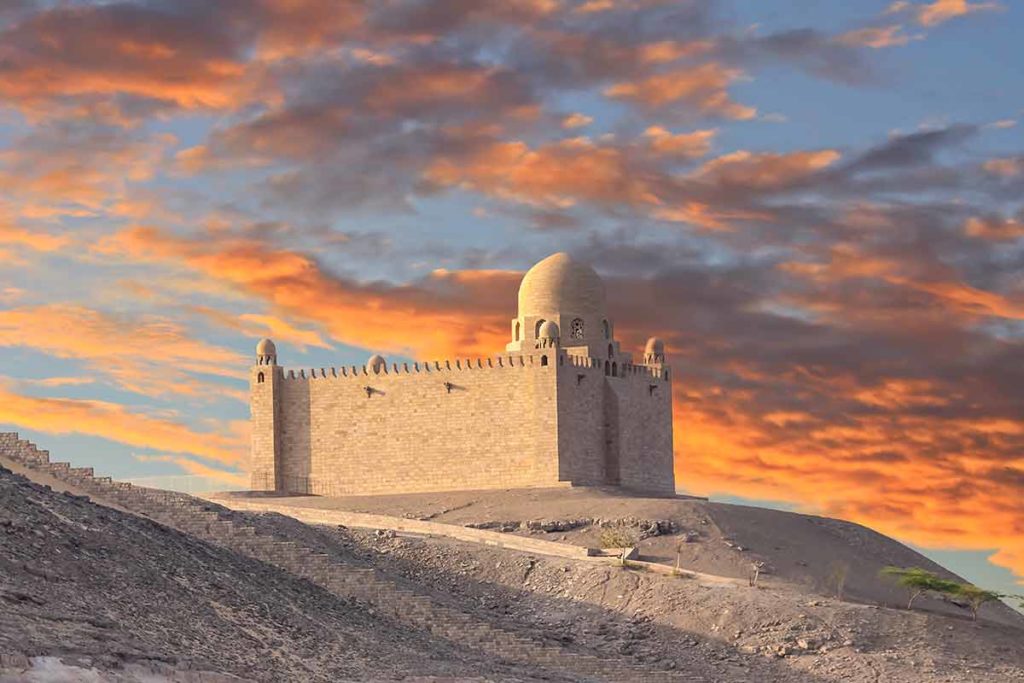
The austere and isolated Mausoleum of the Aga Khan in Aswan on the west bank of the Nile River is a pink granite landmark of Egypt commissioned by the wife of the Aga Khan III (who passed away in 1957).
The title of Aga Khan was created in 1818 by the Shah of Iran, who named Hasan Ali Shah Mahallati (1804–1881) the first Aga Khan.
The first Aga Khan subsequently revolted against the Shah of Iran and escaped to India, where his grandson, the third Aga Khan, became the leader of India’s Muslims.
The current Aga Khan IV is a British citizen and one of the world’s 10 wealthiest royals, with a reported net worth of US$3 billion.
Although his title, “His Highness Prince Karim Aga Khan IV” was recognised by the British Government, and he is the Imam of Ismaili Muslims, the family doesn’t rule a geographic territory.
The Mausoleum of the Aga Khan is open from 9 am to 5 pm.
20- Suez Canal
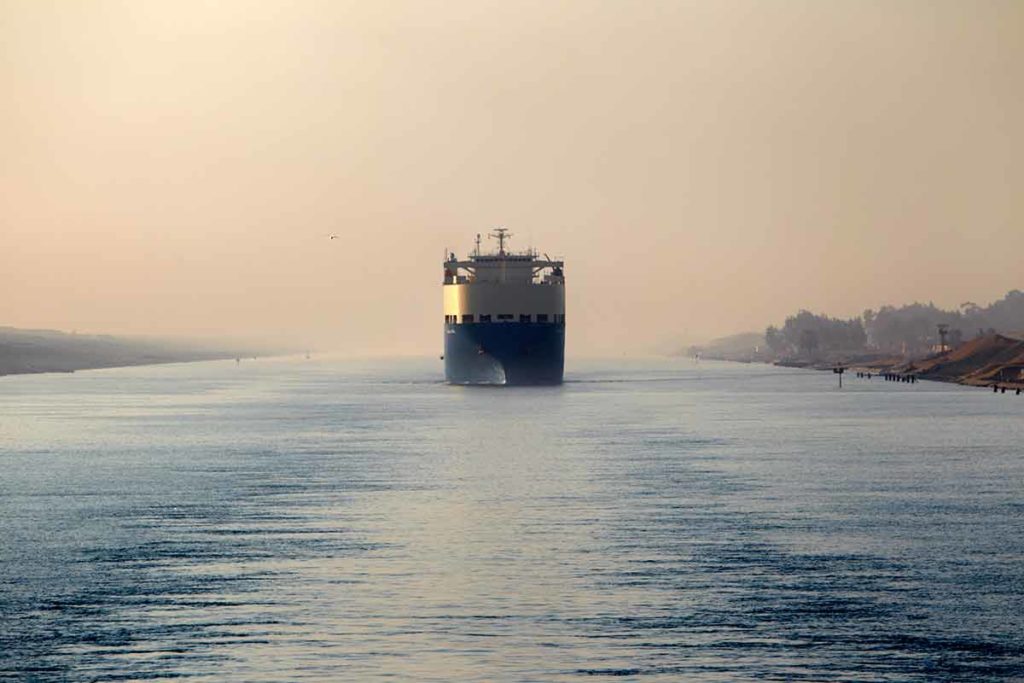
In 1869, the Suez Canal changed the world by connecting the Red Sea with the Mediterranean, opening a shorter route connecting Asia and Europe.
Egyptian canal-building started during the time of Ramses II, but of all canals in Egypt, the Suez Canal stands out as a landmark of Egyptian engineering.
The 120 miles (193 km) shipping channel between Suez and Port Said took 10 years to build with the labour of Egyptian peasants who dug the canal by hand with picks and shovels in the project’s early days.
In the 20th century, Egypt and Israel fought wars over the canal.
20th-Century Egyptian Landmarks
21- Cairo Tower
Completed in 1961, Borg Al-Qahira or Cairo Tower, is a 20th-century monument of Egypt and was the tallest building in Africa until 1971.
Interestingly, at 187m (614 feet), the 90-floor tower is not much higher than the Great Pyramid.
Although it’s a modern structure, the design is a nod to ancient Egypt, with a lattice design that takes inspiration from a famous icon used to represent the sun, creation and re-birth – the lotus plant.
The mural in the lobby is a mosaic of landmarks from the United Arab Republic, which was formed between 1958 and 1971 to unite Egypt and Syria, while the observation deck has a 360-degree view of Cairo and beyond.
Use the telescopes to look at some of the other landmarks in Cairo.
Cairo Tower is open daily from 8 am to midnight (1 am in summer). Tickets cost 60 EGP (free for children under 6).
A luxurious place to stay for a great view of Cairo Towe is the Kempinski Nile Cairo.
Cairo Tower is at Zamalek, Cairo Governorate, Egypt.
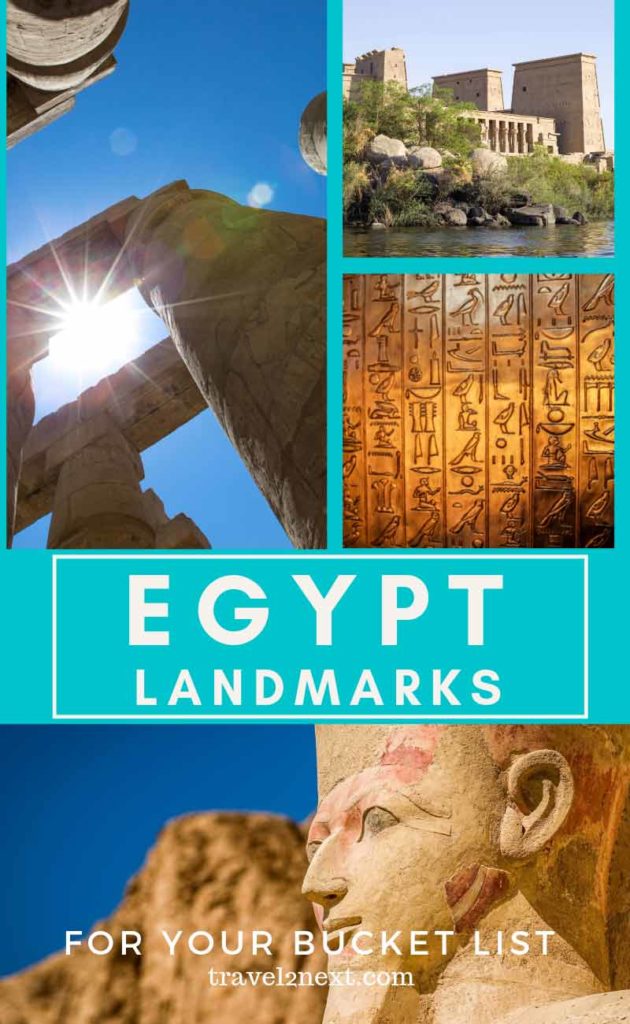
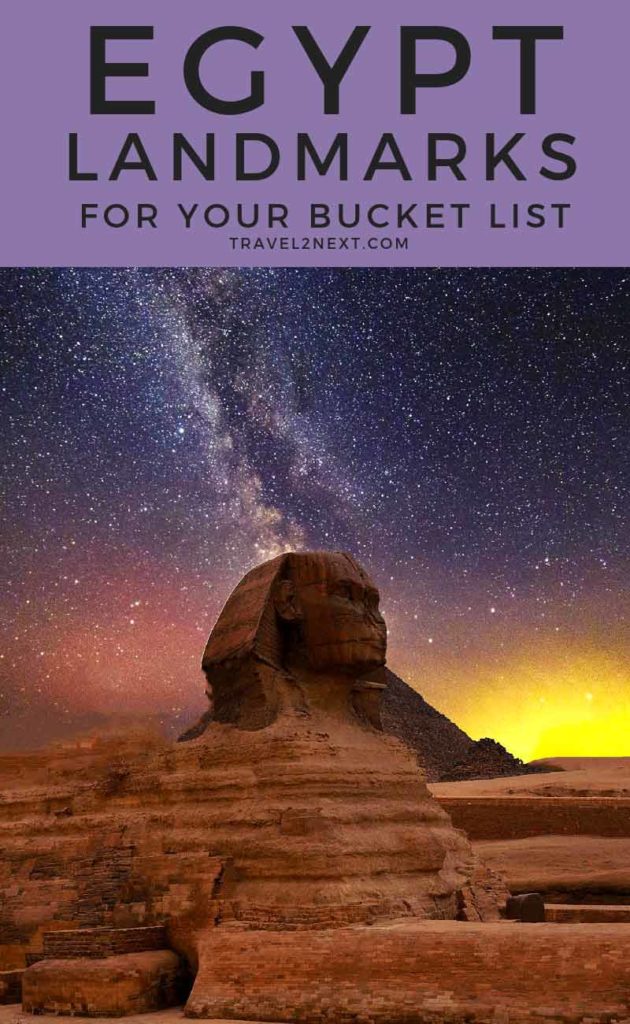
Plan Your Trip

Rent A Car – Find the best car rental rates at Discover Cars. They compare car hire companies to provide you with the best deal right now.

Find A Hotel – If you’re curious about this article and are looking for somewhere to stay, take a look at these amazing hotels.

